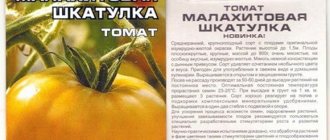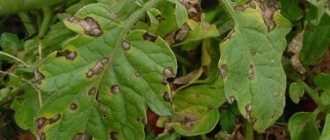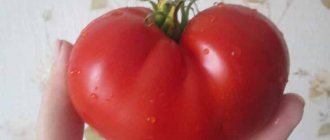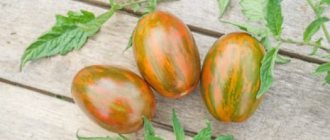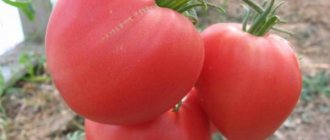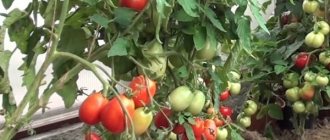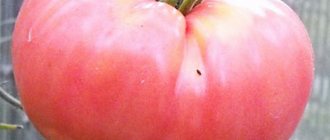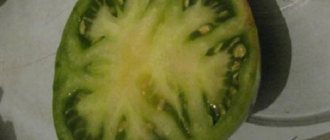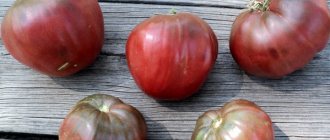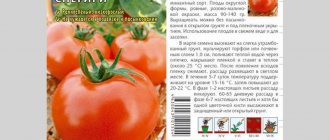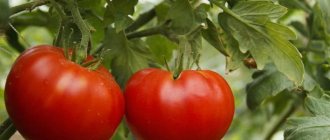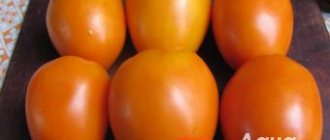Tomato "Benito": description of the variety
| Variety name | Benito |
| general description | Mid-season determinate hybrid |
| Originator | Holland |
| Ripening period | 105-110 days |
| Form | Plum-shaped |
| Color | Red |
| Average weight of tomatoes | 100-140 grams |
| Application | Dining room |
| Productivity of the variety | up to 8 kg per bush |
| Features of cultivation | Standard agricultural technology |
| Disease resistance | Resistant to major diseases |
Tomatoes "Benito" are a high-yielding, mid-season hybrid of the first generation.
The bush is determinate, standard type. The formation of green mass is moderate, the leaf is simple. Tomatoes ripen in clusters of 5-7 pieces. The yield is high; up to 8 kg of tomatoes can be harvested from a bush. The fruits are medium-sized, elongated, plum-shaped, with slightly pronounced ribbing at the stalk. Weight varies from 100 to 140 g. The color is deep red. The elastic, moderately dense glossy skin protects the tomatoes from cracking.
The taste qualities deserve special attention. Ripe tomatoes are sweet, not watery, the flesh is dense, low in seeds. The sugar content reaches 2.4%, dry matter - up to 4.8%.
The information in the table below will help you compare the weight of the fruits of this variety with others:
| Variety name | Fruit weight |
| Benito | 100-140 grams |
| Altaic | 50-300 grams |
| Yusupovsky | 500-600 grams |
| Premier | 120-180 grams |
| Andromeda | 70-300 grams |
| Stolypin | 90-120 grams |
| Red bunch | 30 grams |
| Lazy | 300-400 grams |
| Nastenka | 150-200 grams |
| Honey Heart | 120-140 grams |
| Mazarin | 300-600 grams |
Read on our website: the most common diseases of tomatoes in greenhouses and ways to combat them. Which tomatoes are resistant to most diseases and immune to late blight? What methods of protection against late blight exist?
Useful video
This video tells about tomato pests and ways to combat them:
In the table below you will find links to tomato varieties that ripen at different times:
| Super early | Mid-season | Mid-early |
| Leopold | Nikola | Supermodel |
| Shchelkovsky early | Demidov | Budenovka |
| President 2 | Persimmon | Major F1 |
| Lyana Pink | Honey-sugar | Cardinal |
| Locomotive | Pudovik | Bear Paw |
| Sanka | Rosemary pound | King Penguin |
| Pickling miracle | Beauty King | emerald apple |
Origin and application
Tomatoes “Benito F1” are a hybrid of Dutch selection, intended for growing in greenhouses, film greenhouses or open ground. “Benito” has proven itself well in the regions of Siberia, the Black Earth Region, the Far East, and the Urals. Excellent keeping quality, transportable. Green tomatoes ripen successfully at room temperature.
The fruits of the “Benito” tomato variety are consumed fresh and used for preparing salads, hot dishes, soups, sauces, and purees. Ripe tomatoes produce delicious juice with a rich flavor. Canning is possible; the thick skin preserves the integrity of the fruit.
Advantages and disadvantages
Among the main advantages of the variety:
- tasty, beautiful fruits;
- tomatoes are suitable for fresh consumption, canning, making juices or purees;
- the compact bush does not need support or tying;
- resistant to verticillium, fusarium, and mosaics.
No disadvantages were noticed in the variety. Let's look at the description of Benito tomatoes in terms of cultivation and give some recommendations.
You can compare the yield of this variety with others in the table below:
| Variety name | Productivity |
| Benito | up to 8 kg per bush |
| Nastenka | 10-12 kg per square meter |
| Gulliver | 7 kg per bush |
| Honey Heart | 8.5 kg per square meter |
| Broody | 10-1 kg per square meter |
| Lazy | 15 kg per square meter |
| Brawler | 9 kg per bush |
| Black bunch | 6 kg per bush |
| King of the market | 10-12 kg per square meter |
| De Barao the giant | 20-22 kg per bush |
| Rocket | 6.5 kg per square meter |
Productivity
The Benito tomato enters the fruiting phase within 95...113 days from the moment of emergence. This indicator directly depends on the planting location - greenhouse or soil. It is clear that in protected soil fruiting will occur earlier. Up to 9 fruits are formed on one fruit cluster of a Dutch hybrid.
Fruiting is characterized by elongation and stability. The harvest will be quite decent even in not the most successful years.
The indicator is very high, considering the small size of the tomatoes themselves. The manufacturer claims this value, but in order to actually get such a harvest, you will have to plant Benito in a greenhouse and carefully care for him throughout the season.
In practice, the total yield of the hybrid, subject to standard rules of agricultural technology, is 26 kg/m2. Depending on the landing site, this figure may vary. It has been proven that Benito yields are higher in a greenhouse.
Features of cultivation
The ideal time for sowing “Benito F1” tomato seeds for seedlings is the first half of March. The seed is pre-soaked in a growth stimulant or aloe juice. It is not necessary to disinfect the seeds; they undergo all necessary procedures before packaging and sale.
The soil for seedlings should be light and nutritious. Sod or garden soil is taken as the basis, peat or old humus is added to it. Sowing is carried out in containers or pots, with a depth of 2 cm. The soil is sprayed with warm water and then covered with film to speed up germination.
The emerging sprouts are exposed to bright light, in the sun or under lamps. Water young plants moderately, from a spray bottle or watering can, with warm, settled water. After the first pair of true leaves unfold, the seedlings are planted in separate pots. This is followed by fertilizing with a complete complex fertilizer.
There are a huge number of ways to grow tomato seedlings. We bring to your attention a series of articles on how to do this:
- in twists;
- in two roots;
- in peat tablets;
- without picking;
- using Chinese technology;
- in bottles;
- in peat pots;
- without land.
Planting to a permanent place begins in the second half of May. Plants are moved to the beds closer to the beginning of June. The soil needs to be loosened, and fertilizer is spread over the prepared holes: superphosphate and wood ash. For 1 sq. m there are no more than 3 bushes.
Watering is moderate, only warm water is used. Feeding is required every 2 weeks. They use complex fertilizers based on potassium and phosphorus; they can be alternated with organic matter.
How to grow them?
A pleasant addition to the advantages described above is the fact that the variety is perfect for growing both in open ground and in greenhouses. Of course, you can sow seeds directly into the beds only in the warmest regions of our country - Crimea, Krasnodar Territory. In others, you first have to grow seedlings at home and then plant them in open ground. Alas, in the middle zone, not to mention the more northern regions, summer is not long and sunny enough for one to refuse to use seedlings.
The low height further simplifies cultivation in greenhouses and greenhouses, which can also be called an important advantage.
There are no special differences from other varieties in growing seedlings, planting and caring for them. Therefore, there is no need to describe the features - a more or less experienced summer resident can easily cope with a well-known procedure without unnecessary advice.
Pests and diseases: control and prevention measures
Tomatoes of the "Benito" variety are quite resistant to major diseases , but sometimes troubles occur. Spraying plantings with copper-containing preparations will help prevent late blight. Treatment with phytosporin, as well as frequent ventilation, loosening or mulching of the soil will protect against rot.
Insect pests harm tomatoes at all stages of plant development. Seedlings are threatened by thrips and aphids, adult bushes are attacked by slugs, Colorado potato beetles and mole crickets. Plantings need to be inspected regularly in order to detect uninvited guests in time.
Aphids are washed off with warm soapy water, and flying insects are destroyed using insecticides. Decoctions of herbs also help: celandine, yarrow, chamomile.
The tomato variety “Benito F1” will be an interesting find for lovers of medium-sized sweet fruits. It will also appeal to gardeners planning to start canning. The only problem common to all hybrids is the inability to collect seeds for future sowing in your own beds.
